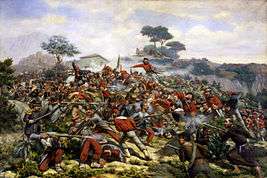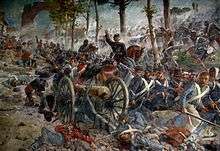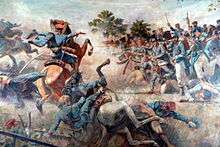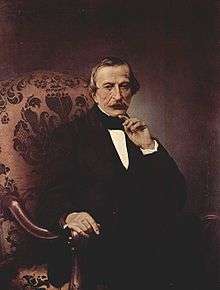Italian unification
.jpg) Five Days of Milan, 18–22 March 1848 | |
| Date | 1815–1871 |
|---|---|
| Location | Italy |
| Participants | Italian society, Kingdom of Sardinia, Provisional Government of Milan, Republic of San Marco, Kingdom of Sicily, Roman Republic, Carbonari, French Empire, Red Shirts, Hungarian legion, Southern Army, United Provinces of Central Italy, Kingdom of Italy |
| Outcome |
|
Part of a series on the |
|---|
| History of Italy |
 |
|
|
|
|
|
|
Italian unification (Italian: Unificazione italiana), or the Risorgimento ([risordʒiˈmento], meaning the Resurgence or revival), was the political and social movement that consolidated different states of the Italian peninsula into the single state of the Kingdom of Italy in the 19th century. The process began in 1815 with the Congress of Vienna and was completed in 1871 when Rome became the capital of the Kingdom of Italy. The memory of the Risorgimento is central to both Italian politics and Italian historiography, for this short period (1815–60) one of the most contested and controversial in modern Italian history. Italian nationalism was based among intellectuals and political activists, often operating from exile.
Background
After the fall of the Western Roman Empire, the Roman province of Italy remained united under the Ostrogothic Kingdom and later disputed between the Kingdom of the Lombards and the Byzantine (Eastern Roman) Empire. Following conquest by the Frankish Empire, the title of King of Italy merged with the office of Holy Roman Emperor. However, the emperor was an absentee foreigner who had little concern for the governance of Italy as a state; as a result, Italy gradually developed into a system of city-states.
This situation persisted through the Renaissance but began to deteriorate with the rise of modern nation-states in the early modern period. Italy, including the Papal States, then became the site of proxy wars between the major powers, notably the Holy Roman Empire (later Austria) and France.
Harbingers of national unity appeared in the treaty of the Italic League, in 1454, and the 15th century foreign policy of Cosimo De Medici and Lorenzo De Medici. Leading Renaissance Italian writers Dante Alighieri, Petrarch, Boccaccio, Niccolò Machiavelli and Francesco Guicciardini expressed opposition to foreign domination. Petrarch stated that the "ancient valour in Italian hearts is not yet dead" in Italia Mia. Niccolò Machiavelli later quoted four verses from Italia Mia in The Prince, which looked forward to a political leader who would unite Italy "to free her from the barbarians".[1]
A sense of Italian national identity was reflected in Gian Rinaldo Carli's Della Patria degli Italiani,[2] written in 1764, which told how a stranger entered a café in Milan and puzzled its occupants by saying that he was neither a foreigner nor a Milanese. 'Then what are you?' they asked. 'I am an Italian,' he explained."[3]
French Revolution
The Italian campaigns of the French Revolutionary Wars destroyed the old structures of feudalism in Italy and introduced modern ideas and efficient legal authority; it provided much of the intellectual force and social capital that fueled unification movements for decades after it collapsed in 1814.[4] The French Republic spread republican principles, and the institutions of republican governments promoted citizenship over the rule of the Bourbons and Habsburgs and other dynasties.[5] The reaction against any outside control challenged Napoleon's choice of rulers. As Napoleon's reign began to fail, the rulers he had installed tried to keep their thrones (among them: Eugène de Beauharnais, viceroy of Italy and Joachim Murat, king of Naples) further feeding nationalistic sentiments. Beauharnais tried to get Austrian approval for his succession to the new Kingdom of Italy, and on 30 March 1815 Murat issued the Rimini Proclamation, which called on Italians to revolt against their Austrian occupiers.
Reaction and dreams 1815-1848
After Napoleon fell the Congress of Vienna (1814–15) restored the pre-Napoleonic patchwork of independent governments. Italy was again controlled largely by the Austrian Empire and the Habsburgs,[6] as they directly controlled the predominantly Italian-speaking northeastern part of Italy and were, together, the most powerful force against unification.
An important figure of this period was Francesco Melzi d'Eril, serving as vice-president of the Napoleonic Italian Republic (1802–1805) and consistent supporter of the Italian unification ideals that would lead to the Italian Risorgimento shortly after his death.[7] Meanwhile, artistic and literary sentiment also turned towards nationalism; Vittorio Alfieri, Francesco Lomonaco and Niccolò Tommaseo are generally considered three great literary precursors of Italian nationalism, but the most famous of proto-nationalist works was Alessandro Manzoni's I promessi sposi (The Betrothed) widely read as a thinly-veiled allegorical critique of Austrian rule. Published in 1827 and extensively revised in the following years the 1840 version of I Promessi Sposi used a standardized version of the Tuscan dialect, a conscious effort by the author to provide a language and force people to learn it.[8]
Exiles dreamed of unification. Three ideals of unification appeared. Vincenzo Gioberti, a Piedmontese priest, had suggested a confederation of Italian states under leadership of the Pope in his 1842 book, Of the Moral and Civil Primacy of the Italians.[9] Pope Pius IX at first appeared interested but he turned reactionary and led the battle against liberalism and nationalism.[10]
Giuseppe Mazzini and Carlo Cattaneo wanted the unification of Italy under a federal republic. That proved too extreme for most nationalists. The middle position—was proposed by Cesare Balbo 1789–1853) as a confederation of separate Italian states led by Piedmont.[11]
The Carbonari
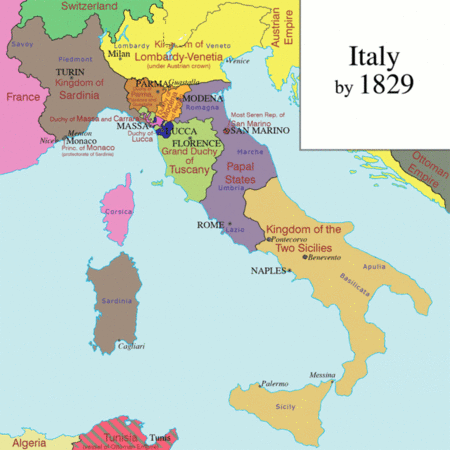
One of the most influential revolutionary groups was the Carbonari, a secret political discussion group formed in Southern Italy early in the 19th century. After 1815 Freemasonry in Italy was repressed and discredited due to its French connections. A void was left that the Carbonari filled with a movement that closely resembled Freemasonry but with a commitment to Italian nationalism and no association with Napoleon and his government. The response came from middle class professionals and business men and some intellectuals. The Carbonari disowned Napoleon but nevertheless were inspired by the principles of the French Revolution regarding liberty, equality and fraternity. They developed their own rituals, and were strongly anticlerical. The Carbonari movement spread across Italy.[12]
Conservative governments feared the Carbonari, imposing stiff penalties on men discovered to be members. Nevertheless the movement survived and continued to be a source of political turmoil in Italy from 1820 until after unification. The Carbonari condemned Napoleon III (who, as a young man, had fought on the side of the Carbonari) to death for failing to unite Italy, and the group almost succeeded in assassinating him in 1858. Many leaders of the unification movement were at one time or other members of this organization. The chief purpose was to defeat tyranny and to establish constitutional government. Though contributing some service to the cause of Italian unity, historians such as Cornelia Shiver doubt that their achievements were proportional to their pretensions.[13]
Giuseppe Mazzini and Giuseppe Garibaldi
Many leading Carbonari revolutionaries wanted a republic,[14] two of the most prominent being Giuseppe Mazzini and Giuseppe Garibaldi. Mazzini's activity in revolutionary movements caused him to be imprisoned soon after he joined. While in prison, he concluded that Italy could − and therefore should − be unified and formulated his program for establishing a free, independent, and republican nation with Rome as its capital. Following his release in 1831, he went to Marseille in France, where he organized a new political society called La Giovine Italia (Young Italy), whose motto was "God and the People", sought the unification of Italy.[15]
Garibaldi, a native of Nice (then part of the Kingdom of Sardinia) participated in an uprising in Piedmont in 1834 and was sentenced to death but he escaped to South America, spending fourteen years in exile, taking part in several wars and learning the art of guerrilla warfare before his return to Italy in 1848.[16]
Early revolutionary activity

Exiles and European and masculine ideals
Many of the key intellectual and political leaders operated from exile; most Risorgimento patriots lived and published their work abroad after successive failed revolutions. Exile became a central theme of the foundational legacy of the Risorgimento as the narrative of the Italian nation fighting for independence.[17] The exiles were deeply immersed in European ideas often hammered away at what Europeans saw as Italian vices, especially effeminacy and indolence. These negative stereotypes emerged from Enlightenment notions of national character that stressed the influence of the environment and history on a people's moral predisposition. Italian exiles both challenged and embraced the stereotypes and typically presented gendered interpretations of Italy's political "degeneration." They called for a masculine response to feminine weaknesses as the basis of a national regeneration, and fashioned their image of the future Italian nation firmly in the standards of European nationalism.[18]
Two Sicilies insurrection
In 1820, Spaniards successfully revolted over disputes about their Constitution, which influenced the development of a similar movement in Italy. Inspired by the Spaniards (who, in 1812, had created their constitution), a regiment in the army of the Kingdom of Two Sicilies, commanded by Guglielmo Pepe, a Carbonaro (member of the secret republican organisation),[19] mutinied, conquering the peninsular part of Two Sicilies. The king, Ferdinand I, agreed to enact a new constitution. The revolutionaries, though, failed to court popular support and fell to Austrian troops of the Holy Alliance. Ferdinand abolished the constitution and began systematically persecuting known revolutionaries. Many supporters of revolution in Sicily, including the scholar Michele Amari, were forced into exile during the decades that followed.[20]
Piedmont insurrection
The leader of the 1821 revolutionary movement in Piedmont was Santorre di Santarosa, who wanted to remove the Austrians and unify Italy under the House of Savoy. The Piedmont revolt started in Alessandria, where troops adopted the green, white, and red tricolore of the Cisalpine Republic. The king's regent, prince Charles Albert, acting while the king Charles Felix was away, approved a new constitution to appease the revolutionaries, but when the king returned he disavowed the constitution and requested assistance from the Holy Alliance. Di Santarosa's troops were defeated, and the would-be Piedmontese revolutionary fled to Paris.[21]
In Milan, Silvio Pellico and Pietro Maroncelli organised several attempts to weaken the hold of the Austrian despotism by indirect educational means. In October 1820, Pellico and Maroncelli were arrested on the charge of carbonarism and imprisoned.[22]
1830 insurrections
Historian Denis Mack Smith argues that:
- Few people in 1830, believed that there might exist an Italian nation. There were eight states in the peninsula, each with distinct laws and traditions. No one had had the desire or the resources to revive Napoleon's partial experiment in unification. The settlement of 1814-15, had merely restored regional divisions, with the added disadvantage that the decisive victory of Austria over France temporarily hindered Italians in playing off their former oppressors against each other.... Italians who, like Foscolo and Rossetti, harboured patriotic sentiments, were driven into exile. The largest Italian state, the Bourbon Kingdom of the Two Sicilies, with its 8 million inhabitants, seemed aloof and indifferent: Sicily and Naples and once formed part of Spain, and it always been foreign to the rest of Italy. The common people in each region, and even the intellectual elite, spoke their mutually unintelligible dialects, and lacked the least vestiges of national consciousness. They wanted good government, not hot self-government, and had welcomed Napoleon and the French as more equitable and efficient than their native dynasties.[23]
After 1830, revolutionary sentiment in favour of a unified Italy began to experience a resurgence, and a series of insurrections laid the groundwork for the creation of one nation along the Italian peninsula.
The Duke of Modena, Francis IV, was an ambitious noble, and he hoped to become king of Northern Italy by increasing his territory. In 1826, Francis made it clear that he would not act against those who subverted opposition toward the unification of Italy. Encouraged by the declaration, revolutionaries in the region began to organize.
During the July Revolution of 1830 in France, revolutionaries forced the king to abdicate and created the July Monarchy with encouragement from the new French king, Louis-Philippe. Louis-Philippe had promised revolutionaries such as Ciro Menotti that he would intervene if Austria tried to interfere in Italy with troops. Fearing he would lose his throne, Louis-Philippe did not, however, intervene in Menotti's planned uprising. The Duke of Modena abandoned his Carbonari supporters, arrested Menotti and other conspirators in 1831, and once again conquered his duchy with help from the Austrian troops. Menotti was executed, and the idea of a revolution centered in Modena faded.
At the same time, other insurrections arose in the Papal Legations of Bologna, Forlì, Ravenna, Imola, Ferrara, Pesaro and Urbino. These successful revolutions, which adopted the tricolore in favour of the Papal flag, quickly spread to cover all the Papal Legations, and their newly installed local governments proclaimed the creation of a united Italian nation. The revolts in Modena and the Papal Legations inspired similar activity in the Duchy of Parma, where the tricolore flag was adopted. The Parmese duchess Marie Louise left the city during the political upheaval.
Insurrected provinces planned to unite as the Province Italiane unite (united Italian Provinces), which prompted Pope Gregory XVI to ask for Austrian help against the rebels. Austrian Chancellor Metternich warned Louis-Philippe that Austria had no intention of letting Italian matters be, and that French intervention would not be tolerated. Louis-Philippe withheld any military help and even arrested Italian patriots living in France.
In early 1831, the Austrian army began its march across the Italian peninsula, slowly crushing resistance in each province that had revolted. This military action suppressed much of the fledgling revolutionary movement, and resulted in the arrest of many radical leaders.[24]
Revolutions of 1848–1849 and First Italian Independence War
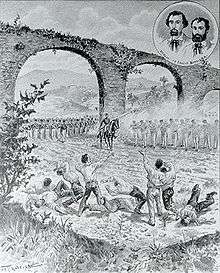
In 1844, two brothers from Venice, Attilio and Emilio Bandiera, members of the Giovine Italia, planned to make a raid on the Calabrian coast against the Kingdom of Two Sicilies and in support of Italian Unification. They assembled a band of about twenty men ready to sacrifice their lives, and set sail on their venture on 12 June 1844. Four days later they landed near Crotone, intending to go to Cosenza, liberate the political prisoners and issue their proclamations. Tragically for the Bandiera brothers, they did not find the insurgent band they were told awaited them, so they moved towards La Sila. They were ultimately betrayed by one of their party, the Corsican Boccheciampe, and by some peasants who believed them to be Turkish pirates. A detachment of gendarmes and volunteers were sent against them, and after a short fight the whole band was taken prisoner and escorted to Cosenza, where a number of Calabrians who had taken part in a previous rising were also under arrest. The Bandiera brothers and their nine companions were executed by firing squad; some accounts state they cried "Viva l’Italia!" (Long live Italy!) as they fell. The moral effect was enormous throughout Italy, the action of the authorities was universally condemned, and the martyrdom of the Bandiera brothers bore fruit in the subsequent revolutions.[25]
On 5 January 1848, the revolutionary disturbances began with a civil disobedience strike in Lombardy, as citizens stopped smoking and playing the lottery, which denied Austria the associated tax revenue. Shortly after this, revolts began on the island of Sicily and in Naples. In Sicily the revolt resulted in the proclamation of the Kingdom of Sicily with Ruggero Settimo as Chairman of the independent state until 1849 when the Bourbon army took back full control of the island on 15 May 1849 by force.[26]
In February 1848, there were revolts in Tuscany that were relatively nonviolent, after which Grand Duke Leopold II granted the Tuscans a constitution. A breakaway republican provisional government formed in Tuscany during February shortly after this concession. On 21 February, Pope Pius IX granted a constitution to the Papal States, which was both unexpected and surprising considering the historical recalcitrance of the Papacy. On 23 February 1848, King Louis Philippe of France was forced to flee Paris, and a republic was proclaimed. By the time the revolution in Paris occurred, three states of Italy had constitutions—four if one considers Sicily to be a separate state.
Meanwhile, in Lombardy, tensions increased until the Milanese and Venetians rose in revolt on 18 March 1848. The insurrection in Milan succeeded in expelling the Austrian garrison after five days of street fights – 18–22 March (Cinque giornate di Milano). An Austrian army under Marshal Josef Radetzky besieged Milan, but due to defection of many of his troops and the support of the Milanese for the revolt, they were forced to retreat.
Soon, Charles Albert, the King of Sardinia (who ruled Piedmont and Savoy), urged by the Venetians and Milanese to aid their cause, decided this was the moment to unify Italy and declared war on Austria (First Italian Independence War). After initial successes at Goito and Peschiera, he was decisively defeated by Radetzky at the Battle of Custoza on 24 July. An armistice was agreed to, and Radetzky regained control of all of Lombardy-Venetia save Venice itself, where the Republic of San Marco was proclaimed under Daniele Manin.
While Radetzky consolidated control of Lombardy-Venetia and Charles Albert licked his wounds, matters took a more serious turn in other parts of Italy. The monarchs who had reluctantly agreed to constitutions in March came into conflict with their constitutional ministers. At first, the republics had the upper hand, forcing the monarchs to flee their capitals, including Pope Pius IX.
Initially, Pius IX had been something of a reformer, but conflicts with the revolutionaries soured him on the idea of constitutional government. In November 1848, following the assassination of his Minister Pellegrino Rossi, Pius IX fled just before Giuseppe Garibaldi and other patriots arrived in Rome. In early 1849, elections were held for a Constituent Assembly, which proclaimed a Roman Republic on 9 February. On 2 February 1849, at a political rally held in the Apollo Theater, a young Roman priest, the Abbé Arduini, had made a speech in which he had declared that the temporal power of the popes was a "historical lie, a political imposture, and a religious immorality.".[27] In early March 1849, Giuseppe Mazzini arrived in Rome and was appointed Chief Minister. In the Constitution of the Roman Republic,[28] religious freedom was guaranteed by article 7, the independence of the pope as head of the Catholic Church was guaranteed by article 8 of the Principi fondamentali, while the death penalty was abolished by article 5, and free public education was provided by article 8 of the Titolo I.

Before the powers could respond to the founding of the Roman Republic, Charles Albert, whose army had been trained by the exiled Polish general Albert Chrzanowski, renewed the war with Austria. He was quickly defeated by Radetzky at Novara on 23 March 1849. Charles Albert abdicated in favour of his son, Victor Emmanuel II, and Piedmontese ambitions to unite Italy or conquer Lombardy were, for the moment, brought to an end. The war ended with a treaty signed on 9 August. A popular revolt broke out in Brescia on the same day as the defeat at Novara, but was suppressed by the Austrians ten days later.
There remained the Roman and Venetian Republics. In April, a French force under Charles Oudinot was sent to Rome. Apparently, the French first wished to mediate between the Pope and his subjects, but soon the French were determined to restore the Pope. After a two-month siege, Rome capitulated on 29 June 1849 and the Pope was restored. Garibaldi and Mazzini once again fled into exile—in 1850 Garibaldi went to New York City. Meanwhile, the Austrians besieged Venice defended by a volunteer army led by Daniele Manin and Guglielmo Pepe, which were forced to surrender on 24 August. Pro-independence fighters were hanged en masse in Belfiore, while the Austrians moved to restore order in central Italy, restoring the princes who had been expelled and establishing their control over the Papal Legations. The revolutions were thus completely crushed.[29]
Cavour and the prospects for unification
Morale was of course badly weakened, but the dream of Risorgimento did not die. Instead, the Italian patriots learned some lessons that made them much more effective at the next opportunity in 1860. Military weakness was glaring, as the small Italian states were completely outmatched by France and Austria. France was a potential ally, and the patriots realize they had to focus all their attention on expelling Austria first, with a willingness to give the French whatever they wanted in return for essential military intervention. The French in fact received Savoy and Nice in 1860. Secondly, the patriots realize that the Pope was an enemy, and could never be the leader of a united Italy. Third they realized that republicanism was too weak a force. Unification had to be based on a strong monarchy, and in practice that meant reliance on Piedmont (the Kingdom of Sardinia) under King Victor Emmanuel II (1820-1878) of the House of Savoy. Count Cavour (1810 – 1861) provided critical leadership. He was a modernizer interested in agrarian improvements, banks, railways and free trade. He opened a newspaper as soon as censorship allowed it: Il Risorgimento called for the independence of Italy, a league of Italian princes, and moderate reforms. He had the ear of the king and in 1852 became prime minister. He ran an efficient active government, promoting rapid economic modernization while upgrading the administration of the army and the financial and legal systems. He sought out support from patriots across Italy. In 1855, the kingdom became an ally of Britain and France in the Crimean war, which gave Cavour's diplomacy legitimacy in the eyes of the great powers.[30][31]
Towards the Kingdom of Italy
The "Pisacane" fiasco
In 1857, Carlo Pisacane, an aristocrat from Naples who had embraced Mazzini's ideas, decided to provoke a rising in the Kingdom of the Two Sicilies. His small force landed on the island of Ponza. It overpowered guards and liberated hundreds of prisoners. In sharp contrast to his hypothetical expectations, there was no local uprising and the invaders were quickly overpowered. Pisacane was killed by angry locals who suspected he was leading a gypsy band trying to steal their food.[32]
The Second Italian Independence War of 1859 and its aftermath
The 2nd War of Italian Independence began in April 1859 when the Sardinian Prime Minister Count Cavour found an ally in Napoleon III. Napoleon III signed a secret alliance and Cavour provoked Austria with military maneuvers and eventually created the war in April 1859. Cavour called for volunteers to enlist in the Italian liberation. The Austrians planned to use their army to beat the Sardinians before the French could come to their aid. Austria had an army of 140,000 men, while the Sardinians had a mere 70,000. This proved less important than it first appeared, however, as Emperor Franz Josef had chosen his officers based on their aristocratic titles and lineage instead of their personal merit. This strategy was no doubt socially acceptable, but the emperor soon discovered blue blood was a remarkably poor guarantor of military victory. Instead of swiftly entering the capital of Sardinia, the Austrian army crawled to the Sardinian capital, taking almost ten days to travel the fifty miles. By this time, the French had reinforced the Sardinians, so the Austrians retreated. Napoleon III's plans worked and at the battle of Solferino, France defeated Austria and forced negotiations. The settlement, by which Lombardy was annexed to Sardinia, left Austria in control of Venice. Sardinia eventually won the Second War of Italian Unification due to statesmanship instead of armies or popular election. The final arrangement was ironed out by "back-room" deals instead of in the battlefield. This was because neither France, Austria, nor Sardinia wanted to risk another battle and could not handle further fighting. All of the sides were eventually unhappy with the final outcome of the 2nd War of Italian Unification and expected another conflict in the future.
The Mille expedition
Thus, by early 1860, only five states remained in Italy—the Austrians in Venetia, the Papal States (now minus the Legations), the new expanded Kingdom of Piedmont-Sardinia, the Kingdom of the Two Sicilies, and San Marino.[35][36][37]
Francis II of the Two Sicilies, the son and successor of Ferdinand II (the infamous "King Bomba"), had a well-organized army of 150,000 men. But his father's tyranny had inspired many secret societies, and the kingdom's Swiss Mercenaries were unexpectedly recalled home under the terms of a new Swiss law that forbade Swiss citizens to serve as mercenaries. This left Francis with only his mostly-unreliable native troops. It was a critical opportunity for the unification movement. In April 1860, separate insurrections began in Messina and Palermo in Sicily, both of which had demonstrated a history of opposing Neapolitan rule. These rebellions were easily suppressed by loyal troops.
In the meantime, Giuseppe Garibaldi, a native of Nice, was deeply resentful of the French annexation of his home city. He hoped to use his supporters to regain the territory. Cavour, terrified of Garibaldi provoking a war with France, persuaded Garibaldi to instead use his forces in the Sicilian rebellions. On 6 May 1860, Garibaldi and his cadre of about a thousand Italian volunteers (called I Mille), steamed from Quarto near Genoa, and, after a stop in Talamone on 11 May, landed near Marsala on the west coast of Sicily.
Near Salemi, Garibaldi's army attracted scattered bands of rebels, and the combined forces defeated the opposing army at Calatafimi on 13 May. Within three days, the invading force had swelled to 4,000 men. On 14 May Garibaldi proclaimed himself dictator of Sicily, in the name of Victor Emmanuel. After waging various successful but hard-fought battles, Garibaldi advanced upon the Sicilian capital of Palermo, announcing his arrival by beacon-fires kindled at night. On 27 May the force laid siege to the Porta Termini of Palermo, while a mass uprising of street and barricade fighting broke out within the city.
With Palermo deemed insurgent, Neapolitan general Ferdinando Lanza, arriving in Sicily with some 25,000 troops, furiously bombarded Palermo nearly to ruins. With the intervention of a British admiral, an armistice was declared, leading to the Neapolitan troops' departure and surrender of the town to Garibaldi and his much smaller army. In Palermo was created the Dictatorship of Garibaldi.
This resounding success demonstrated the weakness of the Neapolitan government. Garibaldi's fame spread and many Italians began to consider him a national hero. Doubt, confusion, and dismay overtook the Neapolitan court—the king hastily summoned his ministry and offered to restore an earlier constitution, but these efforts failed to rebuild the peoples' trust in Bourbon governance.
Six weeks after the surrender of Palermo, Garibaldi attacked Messina. Within a week, its citadel surrendered. Having conquered Sicily, Garibaldi proceeded to the mainland, crossing the Strait of Messina with the Neapolitan fleet at hand. The garrison at Reggio Calabria promptly surrendered. As he marched northward, the populace everywhere hailed him, and military resistance faded: on 18 and 21 August, the people of Basilicata and Apulia, two regions of the Kingdom of Naples, independently declared their annexation to the Kingdom of Italy. At the end of August, Garibaldi was at Cosenza, and, on 5 September, at Eboli, near Salerno. Meanwhile, Naples had declared a state of siege, and on 6 September the king gathered the 4,000 troops still faithful to him and retreated over the Volturno river. The next day, Garibaldi, with a few followers, entered by train into Naples, where the people openly welcomed him.[38]
Defeat of the Kingdom of Naples
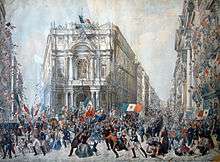
Though Garibaldi had easily taken the capital, the Neapolitan army had not joined the rebellion en masse, holding firm along the Volturno River. Garibaldi's irregular bands of about 25,000 men could not drive away the king or take the fortresses of Capua and Gaeta without the help of the Sardinian army. The Sardinian army, however, could only arrive by traversing the Papal States, which extended across the entire center of the peninsula. Ignoring the political will of the Holy See, Garibaldi announced his intent to proclaim a "Kingdom of Italy" from Rome, the capital city of Pope Pius IX. Seeing this as a threat to the domain of the Catholic Church, Pius threatened excommunication for those who supported such an effort. Afraid that Garibaldi would attack Rome, Catholics worldwide sent money and volunteers for the Papal Army, which was commanded by General Louis Lamoricière, a French exile.
The settling of the peninsular standoff now rested with Napoleon III. If he let Garibaldi have his way, Garibaldi would likely end the temporal sovereignty of the Pope and make Rome the capital of Italy. Napoleon, however, may have arranged with Cavour to leave the king of Sardinia free to take possession of Naples, Umbria and the other provinces, provided that Rome and the "Patrimony of St. Peter" were left intact.[39]
It was in this situation that a Sardinian force of two army corps, under Fanti and Cialdini, marched to the frontier of the Papal States, its objective being not Rome but Naples. The Papal troops under Lamoricière advanced against Cialdini, but were quickly defeated and besieged in the fortress of Ancona, finally surrendering on 29 September. On 9 October, Victor Emmanuel arrived and took command. There was no longer a papal army to oppose him, and the march southward proceeded unopposed.
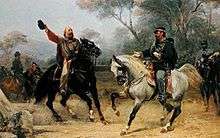
Garibaldi distrusted the pragmatic Cavour, particularly due to Cavour's role in the French annexation of Nice, Garibaldi's birthplace. Nevertheless, he accepted the command of Victor Emmanuel. When the king entered Sessa Aurunca at the head of his army, Garibaldi willingly handed over his dictatorial power. After greeting Victor Emmanuel in Teano with the title of King of Italy, Garibaldi entered Naples riding beside the king. Garibaldi then retired to the island of Caprera, while the remaining work of unifying the peninsula was left to Victor Emmanuel.
The progress of the Sardinian army compelled Francis II to give up his line along the river, and he eventually took refuge with his best troops in the fortress of Gaeta. His courage boosted by his resolute young wife, Duchess Marie Sophie of Bavaria, Francis mounted a stubborn defence that lasted three months. But European allies refused him aid, food and munitions became scarce, and disease set in, so the garrison was forced to surrender. Nonetheless, ragtag groups of Neapolitans loyal to Francis fought on against the Italian government for years to come.
The fall of Gaeta brought the unification movement to the brink of fruition—only Rome and Venetia remained to be added. On 18 February 1861, Victor Emmanuel assembled the deputies of the first Italian Parliament in Turin. On 17 March 1861, the Parliament proclaimed Victor Emmanuel King of Italy, and on 27 March 1861 Rome was declared Capital of Italy, even though it was not actually in the new Kingdom.[40]
Three months later Cavour, having seen his life's work nearly complete, died. When he was given the last rites, Cavour purportedly said: "Italy is made. All is safe."[41]
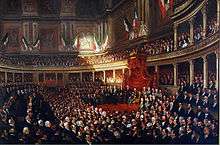
Roman Question
Mazzini was discontent with the perpetuation of monarchical government and continued to agitate for a republic. With the motto "Free from the Alps to the Adriatic", the unification movement set its gaze on Rome and Venice. There were obstacles, however. A challenge against the Pope's temporal dominion was viewed with great distrust by Catholics around the world, and there were French troops stationed in Rome. Victor Emmanuel was wary of the international repercussions of attacking the Papal States, and discouraged his subjects from participating in revolutionary ventures with such intentions.[42]
.jpg)
Nonetheless, Garibaldi believed that the government would support him if he attacked Rome. Frustrated at inaction by the king, and bristling over perceived snubs, he came out of retirement to organize a new venture. In June 1862, he sailed from Genoa and landed again at Palermo, where he gathered volunteers for the campaign, under the slogan Roma o Morte ("Rome or Death"). The garrison of Messina, loyal to the king's instructions, barred their passage to the mainland. Garibaldi's force, now numbering two thousand, turned south and set sail from Catania. Garibaldi declared that he would enter Rome as a victor or perish beneath its walls. He landed at Melito on 14 August and marched at once into the Calabrian mountains.
Far from supporting this endeavour, the Italian government was quite disapproving. General Cialdini dispatched a division of the regular army, under Colonel Pallavicino, against the volunteer bands. On 28 August the two forces met in the Aspromonte. One of the regulars fired a chance shot, and several volleys followed, but Garibaldi forbade his men to return fire on fellow subjects of the Kingdom of Italy. The volunteers suffered several casualties, and Garibaldi himself was wounded; many were taken prisoner. Garibaldi was taken by steamer to Varignano, where he was honorably imprisoned for a time, but finally released.[43]
Meanwhile, Victor Emmanuel sought a safer means to the acquisition of the remaining Papal territory. He negotiated with the Emperor Napoleon for the removal of the French troops from Rome through a treaty. They agreed to the September Convention in September 1864, by which Napoleon agreed to withdraw the troops within two years. The Pope was to expand his own army during that time so as to be self-sufficient. In December 1866, the last of the French troops departed from Rome, in spite of the efforts of the pope to retain them. By their withdrawal, Italy (excluding Venetia and Savoy) was freed from the presence of foreign soldiers.[44]
The seat of government was moved in 1865 from Turin, the old Sardinian capital, to Florence, where the first Italian parliament was summoned. This arrangement created such disturbances in Turin that the king was forced to leave that city hastily for his new capital.[45]
Third War of Independence (1866)
In the Austro-Prussian War of 1866, Austria contested with Prussia the position of leadership among the German states. The Kingdom of Italy seized the opportunity to capture Venetia from Austrian rule and allied itself with Prussia.[46] Austria tried to persuade the Italian government to accept Venetia in exchange for non-intervention. However, on 8 April, Italy and Prussia signed an agreement that supported Italy's acquisition of Venetia, and on 20 June Italy declared war on Austria. Within the context of Italian unification, the Austro-Prussian war is called Third Independence War, after the First (1848) and the Second (1859).[47]
Victor Emmanuel hastened to lead an army across the Mincio to the invasion of Venetia, while Garibaldi was to invade the Tyrol with his Hunters of the Alps. The enterprise ended in disaster. The Italian army encountered the Austrians at Custoza on 24 June and suffered a defeat. On 20 July the Regia Marina was defeated in the battle of Lissa. Italy's fortunes were not all so dismal, though. The following day, Garibaldi's volunteers defeated an Austrian force in the battle of Bezzecca, and moved toward Trento.[48]
Meanwhile, Prussian Minister President Otto von Bismarck saw that his own ends in the war had been achieved, and signed an armistice with Austria on 27 July. Italy officially laid down its arms on 12 August. Garibaldi was recalled from his successful march and resigned with a brief telegram reading only "Obbedisco" ("I obey").
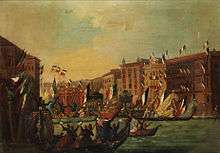
In spite of Italy's poor showing, Prussia's success on the northern front obliged Austria to cede Venetia. Under the terms of a peace treaty signed in Vienna on 12 October, Emperor Franz Joseph had already agreed to cede Venetia to Napoleon III in exchange for non-intervention in the Austro-Prussian War, and thus Napoleon ceded Venetia to Italy on 19 October, in exchange for the earlier Italian acquiescence to the French annexation of Savoy and Nice.
In the peace treaty of Vienna, it was written that the annexation of Venetia would have become effective only after a referendum—taken on 21 and 22 October—to let the Venetian people express their will about being annexed or not to the Kingdom of Italy. Historians suggest that the referendum in Venetia was held under military pressure,[49] as a mere 0.01% of voters (69 out of more than 642,000 ballots) voted against the annexation.[50] However it should be admitted that the re-establishment of a Republic of Venice orphan of Istria and Dalmatia had little chances to develop.
Austrian forces put up some opposition to the invading Italians, to little effect. Victor Emmanuel entered Venice and Venetian land, and performed an act of homage in the Piazza San Marco.[51]
Rome
Mentana and Villa Glori
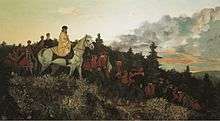
The national party, with Garibaldi at its head, still aimed at the possession of Rome, as the historic capital of the peninsula. In 1867 Garibaldi made a second attempt to capture Rome, but the papal army, strengthened with a new French auxiliary force, defeated his poorly armed volunteers at Mentana. Subsequently, a French garrison remained in Civitavecchia until August 1870, when it was recalled following the outbreak of the Franco-Prussian War.
Before the defeat at Mentana, Enrico Cairoli, his brother Giovanni and 70 companions had made a daring attempt to take Rome. The group had embarked in Terni and floated down the Tiber. Their arrival in Rome was to coincide with an uprising inside the city. On 22 October 1867, the revolutionaries inside Rome seized control of the Capitoline Hill and of Piazza Colonna. Unfortunately for the Cairolis and their companions, by the time they arrived at Villa Glori, on the northern outskirts of Rome, the uprising had already been suppressed. During the night of 22 October 1867, the group was surrounded by Papal Zouaves, and Giovanni was severely wounded. Enrico was mortally wounded and bled to death in Giovanni's arms.
With the Cairoli dead, command was assumed by Giovanni Tabacchi who had retreated with the remaining volunteers into the villa, where they continued to fire at the papal soldiers. These also retreated in the evening to Rome. The survivors retreated to the positions of Garibaldi on the Italian border.
Memorial
At the summit of Villa Glori, near the spot where Enrico died, there is a plain white column dedicated to the Cairoli brothers and their 70 companions. About 100 meters to the left from the top of the Spanish Steps, there is a bronze monument of Giovanni holding the dying Enrico in his arm. A plaque lists the names of their companions. Giovanni never recovered from his wounds and from the tragic events of 1867. According to an eyewitness,[52] when Giovanni died on 11 September 1869:
In the last moments, he had a vision of Garibaldi and seemed to greet him with enthusiasm. I heard (so says a friend who was present) him say three times: "The union of the French to the papal political supporters was the terrible fact!" he was thinking about Mentana. Many times he called Enrico, that he might help him! then he said: "but we will certainly win; we will go to Rome!"
Capture of Rome
In July 1870, the Franco-Prussian War began. In early August, the French Emperor Napoleon III recalled his garrison from Rome, thus no longer providing protection to the Papal State. Widespread public demonstrations illustrated the demand that the Italian government take Rome. The Italian government took no direct action until the collapse of the Second French Empire at the Battle of Sedan. King Victor Emmanuel II sent Count Gustavo Ponza di San Martino to Pius IX with a personal letter offering a face-saving proposal that would have allowed the peaceful entry of the Italian Army into Rome, under the guise of offering protection to the pope. The Papacy, however, exhibited something less than enthusiasm for the plan:
The Pope's reception of San Martino (10 September 1870) was unfriendly. Pius IX allowed violent outbursts to escape him. Throwing the King's letter upon the table he exclaimed, "Fine loyalty! You are all a set of vipers, of whited sepulchres, and wanting in faith." He was perhaps alluding to other letters received from the King. After, growing calmer, he exclaimed: "I am no prophet, nor son of a prophet, but I tell you, you will never enter Rome!" San Martino was so mortified that he left the next day.[53]
The Italian Army, commanded by General Raffaele Cadorna, crossed the papal frontier on 11 September and advanced slowly toward Rome, hoping that a peaceful entry could be negotiated. The Italian Army reached the Aurelian Walls on 19 September and placed Rome under a state of siege. Although now convinced of his unavoidable defeat, Pius IX remained intransigent to the bitter end and forced his troops to put up a token resistance. On 20 September, after a cannonade of three hours had breached the Aurelian Walls at Porta Pia, the Bersaglieri entered Rome and marched down Via Pia, which was subsequently renamed Via XX Settembre. 49 Italian soldiers and four officers, and 19 papal troops died. Rome and Latium were annexed to the Kingdom of Italy after a plebiscite held on 2 October. The results of this plebiscite were accepted by decree of 9 October.
Initially the Italian government had offered to let the pope keep the Leonine City, but the Pope rejected the offer because acceptance would have been an implied endorsement of the legitimacy of the Italian kingdom's rule over his former domain. Pius IX declared himself a prisoner in the Vatican, although he was not actually restrained from coming and going. Rather, being deposed and stripped of much of his former power also removed a measure of personal protection — if he had walked the streets of Rome he might have been in danger from political opponents who had formerly kept their views private. Officially, the capital was not moved from Florence to Rome until July 1871.[54]
Historian Raffaele de Cesare made the following observations about Italian unification:
The Roman question was the stone tied to Napoleon's feet — that dragged him into the abyss. He never forgot, even in August 1870, a month before Sedan, that he was a sovereign of a Catholic country, that he had been made Emperor, and was supported by the votes of the Conservatives and the influence of the clergy; and that it was his supreme duty not to abandon the Pontiff.[55]
For twenty years Napoleon III had been the true sovereign of Rome, where he had many friends and relations…. Without him the temporal power would never have been reconstituted, nor, being reconstituted, would have endured.[56]
Historiography
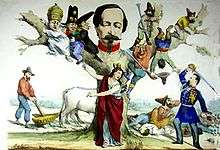
Italian unification is still a topic of debate. According to Massimo d'Azeglio, centuries of foreign domination created remarkable differences in Italian society, and the role of the newly formed government was to face these differences and to create a unified Italian society. Still today the most famous quote of Massimo d'Azeglio is, "L'Italia è fatta. Restano da fare gli italiani" (Italy has been made. Now it remains to make Italians).[57]
The economist and politician Francesco Saverio Nitti criticized the newly created state for not taking in to consideration the substantial economic differences between Northern Italy, a free market economy, and Southern Italy, a state protectionism economy, when integrating the two. When the Kingdom of Italy extended the free market economy to the rest of the country, the South's economy collapsed under the weight of the North's. Nitti contended that this change should have been much more gradual in order to allow the birth of an adequate entrepreneurial class able to make strong investments and initiatives in the south. These mistakes, he felt, were the cause of the economic and social problems which came to be known as the Southern Question (Questione Meridionale).[58][59]
The politician, historian, and writer Gaetano Salvemini commented that even though Italian Unification had been a strong opportunity for both a moral and economic rebirth of Italy's Mezzogiorno (Southern Italy), due to lack of understanding and action on the part of politicians, corruption and organized crime flourished in the South.[60] The Marxist theorist Antonio Gramsci criticized Italian Unification for the limited presence of the masses in politics, as well as the lack of modern land reform in Italy.[61]
Revisionism of Risorgimento produced a clear radicalization of Italy in the mid-twentieth century, following the fall of the Savoy monarchy and fascism during World War II. Reviews of the historical facts concerning Italian unification's successes and failures continue to be undertaken by domestic and foreign academic authors, including Denis Mack Smith, Christopher Duggan, and Lucy Riall. Recent work emphasizes the central importance of nationalism.[62][63]
Risorgimento and irredentism
The process of unification of the Italian people in a national state was not completed in the nineteenth century. Many Italians remained outside the borders of the Kingdom of Italy and this situation created the Italian irredentism.
Italia irredenta (Unredeemed Italy) was an Italian nationalist opinion movement that emerged after Italian unification. It advocated irredentism among the Italian people as well as other nationalities who were willing to become Italian and as a movement; it is also known as "Italian irredentism". Not a formal organization, it was just an opinion movement that claimed that Italy had to reach its "natural borders". Similar patriotic and nationalistic ideas were common in Europe in the 19th century.[64]
Irredentism and the two World Wars
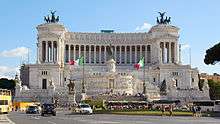
During the post-unification era, some Italians were dissatisfied with the current state of the Italian Kingdom since they wanted the kingdom to include Trieste, Istria, and other adjacent territories, as well. This Italian irredentism succeeded in World War I with the annexation of Trieste and Trento, with the respective territories of Venezia Giulia and Trentino.
The Kingdom of Italy had declared neutrality at the beginning of the war, officially because the Triple Alliance with Germany and Austria-Hungary was a defensive one, requiring its members to come under attack first. Many Italians were still hostile to Austria's continuing occupation of ethnically Italian areas, and Italy chose not to enter. Austria-Hungary requested Italian neutrality, while the Triple Entente (which included Great Britain, France and Russia) requested its intervention. With the London Pact, signed in April 1915, Italy agreed to declare war against the Central Powers, in exchange for the irredent territories of Friuli, Trentino, and Dalmatia (see Italia irredenta).
Italian irredentism obtained an important result after the First World War, when Italy gained Trieste, Gorizia, Istria, and the city of Zara. During the Second World War, after the Axis attack on Yugoslavia, Italy created the "Governatorato di Dalmazia" (from 1941 to September 1943), so the Kingdom of Italy annexed temporarily even Split (Italian Spalato), Kotor (Cattaro), and most of coastal Dalmatia. From 1942 to 1943, even Corsica and Nice (Italian Nizza) were temporarily annexed to the Kingdom of Italy, nearly fulfilling in those years the ambitions of Italian irredentism.
For its avowed purpose the movement had the "emancipation" of all Italian lands still subject to foreign rule after Italian unification. The Irredentists took language as the test of the alleged Italian nationality of the countries they proposed to emancipate, which were Trentino, Trieste, Dalmatia, Istria, Gorizia, Ticino, Nice (Nizza), Corsica, and Malta. Austria-Hungary promoted Croat interests in Dalmatia and Istria to weaken Italian claims in the western Balkans before the First World War.[65]
After World War II
After WWII the irredentism movement faded away in Italian politics. Only a few thousand Italians remain in Istria and Dalmatia as a consequence of the Italian defeat in WWII and the slaughter of thousands of Italians as reprisals for fascist atrocities, and the subsequent departure of approximately 400,000 people in what became known as the Istrian exodus. 350,000 refugees were ethnic Italians (76% of which born in the territories surrendered), the others being ethnic Slovenians, ethnic Croatians, and ethnic Istro-Romanians, choosing to maintain Italian citizenship.[66]
Anniversary of Risorgimento
| Anniversary of Risorgimento | |
|---|---|
 Monument to Italia Turrita in Reggio Calabria | |
| Observed by | Italy |
| Type | National |
| Significance | Proclamation of the Kingdom of Italy on 17 March 1861 |
| Celebrations | Parades, Fireworks, Concerts, Picnics, Balls, Trade shows |
| Date | 17 March |
| Frequency | every fifty years |
Italy celebrates the Anniversary of Risorgimento every fifty years, on 17 March (date of proclamation of the Kingdom of Italy). The anniversary occurred in 1911 (50th), 1961 (100th) and 2011 (150th) with several celebrations throughout the country.[67]
- 150th Anniversary of Risorgimento
- Celebration in Florence
- A castle near Modena
- Mole Antonelliana during the anniversary, Turin
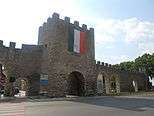
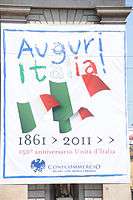 Banner in Milan
Banner in Milan
 Ferrari Formula One car with the logo of the 150th anniversary of Risorgimento
Ferrari Formula One car with the logo of the 150th anniversary of Risorgimento
Culture and Risorgimento
Art
.jpg)
In art, this period was characterised by the Neoclassicism that draws inspiration from the "classical" art and culture of Ancient Greece or Ancient Rome. The main Italian sculptor was Antonio Canova who became famous for his marble sculptures that delicately rendered nude flesh. The mourning Italia turrita on the tomb to Vittorio Alfieri is one of the main works of Risorgimento by Canova.
Francesco Hayez was another remarkable artist of this period whose works often contain allegories about Italian unification. His most known painting The Kiss aims to portray the spirit of the Risorgimento: the man wears red, white and green, representing the Italian patriots fighting for independence from the Austro-Hungarian empire while the girl's pale blue dress signifies France, which in 1859 (the year of the painting's creation) made an alliance with the Kingdom of Piedmont and Sardinia enabling the latter to unify the many states of the Italian peninsula into the new kingdom of Italy. Hayez's three paintings on the Sicilian Vespers are an implicit protest against the foreign domination of Italy.
Andrea Appiani, Domenico Induno and Gerolamo Induno are also known for their patriotic canvases. Risorgimento was also represented by works not necessarily linked to Neoclassicism as in the case of Giovanni Fattori who was one of the leaders of the group known as the Macchiaioli that soon became a leading Italian plein-airists, painting landscapes, rural scenes, and scenes of military life during the Italian unification.[68]
Literature

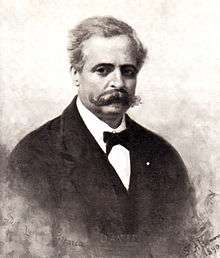
In literature, lots of works were dedicated to Risorgimento since the beginning. The most known writer of Risorgimento is Alessandro Manzoni whose works are a symbol of the Italian unification, both for its patriotic message and because of his efforts in the development of the modern, unified Italian language; he is famous for the novel The Betrothed (orig. Italian: I Promessi Sposi) (1827), generally ranked among the masterpieces of world literature.
Vittorio Alfieri, was the founder of a new school in the Italian drama, expressed in several occasions his suffering about the foreign domination's tyranny.
Ugo Foscolo describes in his works the passion and love for the fatherland and the glorious history of the Italian people; these two concepts are respectively well expressed in two masterpieces, The Last Letters of Jacopo Ortis and Dei Sepolcri.
Vincenzo Monti, known for the Italian translation of the Iliad, described in his works both enthusiasms and disappointments of Risorgimento until his death.
Giovanni Berchet wrote a poetry characterised by a high moral, popular and social content; he also contributed to Il Conciliatore, a progressive bi-weekly scientific and literary journal, influential in the early Risorgimento that was published in Milan from September 1818 until October 1819 when it was closed by the Austrian censors; its writers included also Ludovico di Breme, Giuseppe Nicolini and Silvio Pellico.
Giacomo Leopardi was one of the most important poets of Risorgimento thanks to works such as Canzone all'Italia and Risorgimento.
Niccolò Tommaseo, the editor of the Italian Language Dictionary in eight volumes, was a precursor of the Italian irredentism and his works are a rare examples of a metropolitan culture above nationalism; he supported the liberal revolution headed by Daniele Manin against the Austrian Empire and he will always support the unification of Italy.
Francesco de Sanctis was one of the most important scholars of Italian language and literature in the 19th century; he supported the Revolution of 1848 in Naples and for this reason he was imprisoned for three years; his reputation as a lecturer on Dante in Turin brought him the appointment of professor at ETH Zürich in 1856; he returned to Naples as Minister of Public Education after the unification of Italy.
The writer and patriot Luigi Settembrini published anonymously the Protest of the People of the Two Sicilies, a scathing indictment of the Bourbon government and was imprisoned and exiled several times by the Bourbons because of his support to Risorgimento; after the formation of the Kingdom of Italy, he was appointed professor of Italian literature at the University of Naples.
Ippolito Nievo is another main representant of Risorgimento with his novel Confessioni d'un italiano; he fought with Giuseppe Garibaldi's Expedition of the Thousand.
Risorgimento was also depicted in several famous novels: The Leopard written by Giuseppe Tomasi di Lampedusa, Heart by Edmondo De Amicis and Piccolo mondo antico by Antonio Fogazzaro.[69]
Opera
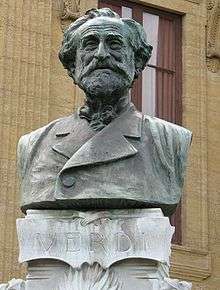

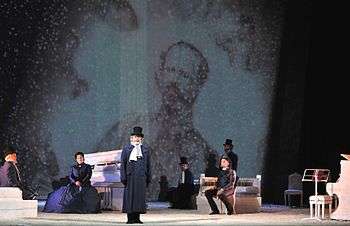
Risorgimento won the support of many leading Italian opera composers.[70] Their librettos often saw a delicate balance between European romantic narratives and dramatic themes evoking nationalistic sentiments. Ideas expressed in operas stimulated the political mobilisation in Italy and among the cultured classes of Europe who appreciated Italian opera. Furthermore Mazzini and many other nationalists found inspiration in musical discourses.[71]
In his L'italiana in Algeri (The Italian Girl in Algiers), Gioachino Rossini expressed his support to the unification of Italy; the patriotic line Pensa alla patria, e intrepido il tuo dover adempi: vedi per tutta Italia rinascere gli esempi d’ardir e di valor / "Think about the fatherland and intrepid do your duty: see for all Italy the birth of the examples of courage and value" was censored in the Kingdom of Two Sicilies.
Vincenzo Bellini was a secret member of the Carbonari and in his masterpiece I puritani (The Puritans), the last part of Act 2 is an allegory to Italian unification. Another Bellini opera, Norma, was at the center of an unexpected standing ovation during its performance in Milan in 1859: while the chorus was performing Guerra, guerra! Le galliche selve (War, war! The Gallic forests) in Act 2, the Italians began to greet the chorus with loud applause and to yell the word "War!" several times towards the Austrian officers at the opera house.[72]
The relationship between Gaetano Donizetti and the Risorgimento is still controversial; even though Giuseppe Mazzini tried to use some of Donizetti's works for promoting the Italian cause, Donizetti had always preferred not to get involved in politics.[73]
Historians vigorously debate how political were the operas of Giuseppe Verdi (1813-1901). In particular, the Chorus of the Hebrew Slaves (known as Va, pensiero) from the third act of the opera Nabucco was intended to be an anthem for Italian patriots, who were seeking to unify their country and free it from foreign control in the years up to 1861 (the chorus's theme of exiles singing about their homeland, and its lines like O mia patria, si bella e perduta / "O my country, so lovely and so lost" was thought to have resonated with many Italians).[74] Beginning in Naples in 1859 and spreading throughout Italy, the slogan "Viva VERDI" was used as an acronym for Viva Vittorio Emanuele Re D'Italia (Viva Victor Emmanuel King of Italy), referring to Victor Emmanuel II.[75][76]
Franco DellaPeruta argues in favour of close links between the operas and the Risorgimento, emphasizing Verdi's patriotic intent and links to the values of the Risorgimento. Verdi started as a republican, became a strong supporter of Cavour and entered the Italian parliament on Cavour's suggestion. His politics caused him to be frequently in trouble with the Austrian censors. Verdi's main works of 1842-49 were especially relevant to the struggle for independence, including 'Nabucco' (1842), 'I Lombardi alla Prima Crociata' (1843), 'Ernani' (1844), 'Attila' (1846), 'Macbeth' (1847), and 'La Battaglia di Legnano' (1848). However, starting in the 1850s, his operas showed few patriotic themes because of the heavy censorship of the absolutist regimes in power. Verdi later became disillusioned by politics, but he was personally active part in the political world of events of the Risorgimento and was elected to the first Italian parliament in 1861.[77] Likewise Marco Pizzo argues that after 1815 music became a political tool, and many song writers expressed ideals of freedom and equality. Pizzo says Verdi was part of this movement, for his operas were inspired by the love of country, the struggle for Italian independence, and speak to the sacrifice of patriots and exiles.[78] On the other side of the debate, Mary Ann Smart argues that music critics at the time seldom mentioned any political themes.[79] Likewise Roger Parker argues that the political dimension of Verdi's operas was exaggerated by nationalistic historians looking for a hero in the late 19th century.[80]
The Risorgimento is the subject of a 2011 opera, Risorgimento! by Italian composer Lorenzo Ferrero, written to commemorate the 150th anniversary of the Italian unification.
Films
The Leopard is a film from 1963, based on the novel by Giuseppe Tomasi di Lampedusa, and directed by Luchino Visconti. It features Burt Lancaster as the eponymous character, the Prince of Salina. The film depicts his reaction to the Risorgimento, and his vain attempts to retain his social standing.
There are other movies set in this period:
- 1860 (1934), by Alessandro Blasetti
- Piccolo mondo antico (1941), by Mario Soldati
- Un garibaldino al convento (1942), by Vittorio De Sica
- Heart and Soul (1948), by Vittorio De Sica
- Senso (1954), by Luchino Visconti
- Garibaldi (1961), by Roberto Rossellini
- 1870 (1971), by Alfredo Giannetti
- Noi credevamo (2010), by Mario Martone
Maps of Italy before and during Italian unification
 Italy in 1494
Italy in 1494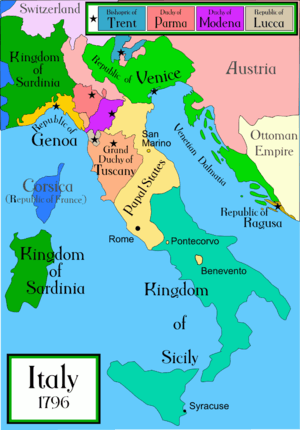 Italy in 1796
Italy in 1796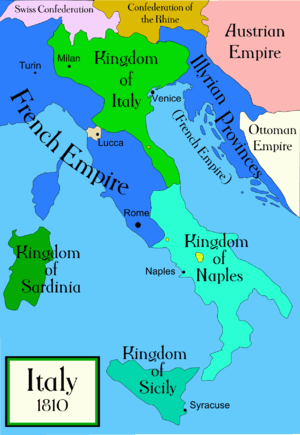 Italy in 1810
Italy in 1810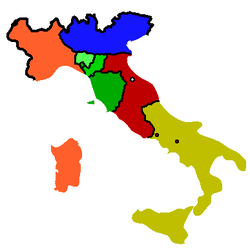 Italy in 1859: orange Kingdom of Sardinia, blue Kingdom of Lombardy–Venetia (Austrian Empire), light green Duchy of Parma, green Duchy of Modena, dark green Grand Duchy of Tuscany, red Papal States, yellow Kingdom of Two Sicilies.
Italy in 1859: orange Kingdom of Sardinia, blue Kingdom of Lombardy–Venetia (Austrian Empire), light green Duchy of Parma, green Duchy of Modena, dark green Grand Duchy of Tuscany, red Papal States, yellow Kingdom of Two Sicilies.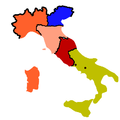 Italy in 1860: orange Kingdom of Sardinia, blue Kingdom of Lombardy–Venetia (Austrian Empire), pink United Provinces of Central Italy, red Papal States, yellow Kingdom of Two Sicilies.
Italy in 1860: orange Kingdom of Sardinia, blue Kingdom of Lombardy–Venetia (Austrian Empire), pink United Provinces of Central Italy, red Papal States, yellow Kingdom of Two Sicilies.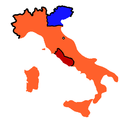 Italy in 1861: orange Kingdom of Italy, blue Kingdom of Lombardy–Venetia (Austrian Empire), red Papal States.
Italy in 1861: orange Kingdom of Italy, blue Kingdom of Lombardy–Venetia (Austrian Empire), red Papal States.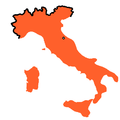 Kingdom of Italy in 1870
Kingdom of Italy in 1870 Kingdom of Italy in 1919
Kingdom of Italy in 1919
References
- ↑ Machiavelli and Empire – Mikael Hörnqvist – Google Books. Books.google.com. 25 November 2004. ISBN 9781139456340. Retrieved 1 August 2012.
- ↑ Antonio Trampus, "Gianrinaldo Carli at the centre of the Milanese Enlightenment." History of European ideas 32#4 (2006): 456-476.
- ↑ Holt, Edgar (1971). The Making of Italy: 1815–1870. New York: Murray Printing Company. pp. 22–23.
- ↑ Raymond Grew, "Finding social capital: the French revolution in Italy." Journal of Interdisciplinary History 29#3 (1999): 407-433. online
- ↑ Anna Maria Rao, " Republicanism in Italy from the eighteenth century to the early Risorgimento," Journal of Modern Italian Studies (2012) 17#2 pp 149-167.
- ↑ "How Napoleon became 'King of Italy'". Napoleon.org. 23 October 2012. Retrieved 28 January 2015.
- ↑ Nicassio, Susan Vandiver (2009). Imperial City: Rome Under Napoleon (University of Chicago Press ed.). United States of America: University of Chicago Press. p. 220. ISBN 978-0-226-57973-3.
- ↑ "DigiTool – Results – Full". Digitool.fcla.edu. Retrieved 30 September 2014.
- ↑ Roberto Romani, "Liberal theocracy in the Italian risorgimento." European History Quarterly 44#4 (2014): 620-650.
- ↑ E.E.Y. Hales (1954). Pio Nono: A Study in European Politics and Religion in the Nineteenth Century. P.J. Kenedy.
- ↑ Maurizio Isabella, "Aristocratic Liberalism and Risorgimento: Cesare Balbo and Piedmontese Political Thought after 1848." History of European Ideas 39#6 (2013): 835-857.
- ↑ R. John Rath, "The Carbonari: Their Origins, Initiation Rites, and Aims," American Historical Review (1964) 69#2 pp. 353-370 online
- ↑ Cornelia Shiver, "The Carbonari." Social Science (1964): 234-241. in JSTOR
- ↑ Galt, Anthony (December 1994). "The Good Cousins' Domain of Belonging: Tropes in Southern Italian Secret Society Symbol and Ritual, 1810–1821". Man, New Series. 29 (4): 785–807. JSTOR 3033969.
- ↑ Denis Mack Smith, Mazzini (1996).
- ↑ Jasper Ridley, Garibaldi (2001)
- ↑ Maurizio Isabella, "Exile and Nationalism: The Case of the Risorgimento" European History Quarterly" (2006) 36#4 pp 493-520.
- ↑ Silvana Patriarca, "Indolence and Regeneration: Tropes and Tensions of Risorgimento Patriotism," American Historical Review (2005) 110#2 pp 380-408. in JSTOR
- ↑ "Carbonaro – definition of Carbonaro by The Free Dictionary". Thefreedictionary.com. Retrieved 28 January 2015.
- ↑ "Austria Two Sicilies Revolt 1820–1821". Onwar.com. Retrieved 30 September 2014.
- ↑ Michael Broers, "Revolution as Vendetta: Patriotism in Piedmont, 1794–1821." Historical Journal 33#3 (1990): 573-597.
- ↑ Gavriel Shapiro, "Nabokov and Pellico: Invitation to a Beheading and My Prisons." Comparative Literature 62#1 (2010): 55-67.
- ↑ D. Mack Smith, "Italy" in J.P.T. Bury, ed., The New Cambridge Modern History, Vol. 10: The Zenith of European Power, 1830-70 (1960) p 552.
- ↑ Archived 2 December 2013 at the Wayback Machine.
- ↑ "Bandiera brothers". Encyclopedia Britannica. Retrieved 30 September 2014.
- ↑ "Two Sicilies, Kingdom of, 1848–49". Ohio.edu. Retrieved 30 September 2014.
- ↑ Ridley, Jasper. Garibaldi. p. 268.
- ↑ Full text of the constitution can be found at:
"Costituzione della Repubblica Romana (1849)" (in Italian). Archived from the original on 9 February 2009.
"Costituzione della Repubblica Romana, 1849" (PDF). Liberliber website (in Italian). Retrieved 19 March 2012. - ↑ "Daniele Manin". Ohio.edu. Retrieved 30 September 2014.
- ↑ Enrico Dal Lago, "Lincoln, Cavour, and National Unification: American Republicanism and Italian Liberal Nationalism in Comparative Perspective." The Journal of the Civil War Era 3#1 (2013): 85-113.
- ↑ William L. Langer, ed., an encyclopedia of World Cup history (4th ed. 1968) pp 704-7.
- ↑ Martin Collier (2003). Italian Unification, 1820-71. Heinemann. p. 51.
- ↑ "Wars of Italian Unification". Heritage History. Heritage History.
- ↑ Avery, Robert. "The Victorian Web". Retrieved 27 March 2015.
- ↑ Barbagallo, Francesco (1980). Mezzogiorno e questione meridionale. Napoli: Guida. p. 9.
- ↑ Seaman, L. C. B. (1980). "Proved Only Negative Propositions". In Delzell, Charles. The Unification of Italy, 1859–1861: Cavour, Mazzini, or Garibaldi?. New York: Hold, Rinehart, and Winston. p. 72.
- ↑ Commissione nazionale per la pubblicazione dei carteggi del Conte di Cavour (2005). Camillo Cavour: Epistolario. 17. Firenze: Olschki. p. 2944.
La Sicilia sarà una delle più belle gemme della sua corona; ed uno degli elementi più vitali della nazione
- ↑ "Spedizione Dei Mille nell'Enciclopedia Treccani". Treccani, l'Enciclopedia italiana. Retrieved 30 September 2014.
- ↑ Charles T. Evans. "Garibaldi and the Risorgimento". Novaonline.nvcc.edu. Retrieved 30 September 2014.
- ↑ "Regno Delle Due Sicilie nell'Enciclopedia Treccani". Treccani.it. Retrieved 28 January 2015.
- ↑ Holt, Edgar (1971). The Making of Italy: 1815–1870. New York: Murray Printing Company. p. 258.
- ↑ Mack Smith, Italy: a modern history (1969) pp 89-100.
- ↑ Mack Smith, Italy: a modern history (1969) pp 63-65.
- ↑ John W. Bush, Venetia Redeemed; Franco-Italian Relations, 1864-1866 (Syracuse University Press, 1967).
- ↑ Mack Smith, Italy: a modern history (1969) pp 65-66.
- ↑ Denis Mack Smith, Italy: a modern history (1969) pp 76-82.
- ↑ "Italian Risorgimento". Welcometorome.net. Retrieved 30 September 2014.
- ↑ Kennedy Hickman. "Battle of Lissa – Third Italian War Battle of Lissa". About. Retrieved 30 September 2014.
- ↑ G. Thaon di Revel: "La cessione del Veneto—ricordi di un commissario piemontese incaricato alle trattative" (translation: "The cession of Veneto—memories of the piedmontese commissary for the negotiations"). Academic Press, 2002
- ↑ Beggiato, E.: "1866: la grande truffa" (translation: "1866: the great deceit"). Venice Academic Press, 1999
- ↑ "The Austro-Prussian War and Third War of Italian Unification (1866)". Victorianweb.org. Retrieved 30 September 2014.
- ↑ Michele Rosi, I Cairoli, L. Capelli Ed., Bologna, 1929, pp. 223–224
- ↑ De Cesare, Raffaele (1909). The Last Days of Papal Rome. Archibald Constable & Co. p. 444.
- ↑ "La breccia di Porta Pia". 150anni-lanostrastoria.it. Retrieved 30 September 2014.
- ↑ De Cesare, Raffaele (1909). The Last Days of Papal Rome. Archibald Constable & Co. p. 440.
- ↑ De Cesare, Raffaele (1909). The Last Days of Papal Rome. Archibald Constable & Co. p. 443.
- ↑ "Massimo D Azeglio nell'Enciclopedia Treccani". Treccani.it. Retrieved 28 January 2015.
- ↑ Francesco Saverio Nitti, L'Italia all'alba del secolo XX, Casa Editrice Nazionale Roux e Viarengo, Torino-Roma, 1901
- ↑ Francesco Saverio Nitti, Domenico De Masi, Napoli e la questione meridionale, Guida, Napoli, 2004
- ↑ Lucy Riall, "Which road to the south? Revisionists revisit the Mezzogiorno." Journal of Modern Italian Studies 5#1 (2000): 89-100.
- ↑ John M. Cammett, "Two recent polemics on the character of the Italian Risorgimento." Science & Society 27#4 (1963): 433-457. in JSTOR
- ↑ Silvana Patriarca and Lucy Riall, eds. (2012). The Risorgimento Revisited: Nationalism and Culture in Nineteenth-Century Italy. Palgrave Macmillan. pp. 1–3.
- ↑ Eugenio F. Biagini, review of "The Risorgimento Revisited: Nationalism and Culture in Nineteenth-century Italy: Recent works on the Risorgimento Edited by Andrea del Cornò and Nick Carter" Modern Italy (2014) 19#3 online
- ↑ Felluga. "Alison Chapman, "On Il Risorgimento"". Branchcollective.org. Retrieved 30 September 2014.
- ↑ "Irredentismo in "Enciclopedia Italiana" – Treccani". Treccani.it. Retrieved 31 May 2015.
- ↑ Benedetta Tobagi. "La Repubblica italiana | Treccani, il portale del sapere". Treccani.it. Retrieved 28 January 2015.
- ↑ "Le celebrazioni del Risorgimento della Provincia di Roma". 150anni-lanostrastoria.it. Retrieved 30 September 2014.
- ↑ "Risorgimento – Pensiero e cultura – 1848". Cronlogia.leonardo.it. Retrieved 30 September 2014.
- ↑ "Risorgimento e poesia – Giorgio Weiss". Giorgioweiss.it. Retrieved 30 September 2014.
- ↑ Axel Körner, "Opera and nation in nineteenth‐century Italy: conceptual and methodological approaches." Journal of Modern Italian Studies 17#4 (2012): 393-399.
- ↑ Carlotta Sorba, "Between cosmopolitanism and nationhood: Italian opera in the early nineteenth century." Modern Italy 19.1 (2014): 53-67.
- ↑ "Dal Risorgimento all'Italia unita". Sivainitalia.it. Retrieved 30 September 2014.
- ↑ Rosa Maria Mazzola, "Rossini, Bellini, Donizetti and the Risorgimento" Piranesi150.altervista.org, Retrieved 9 September 2014
- ↑ "Modern History Sourcebook: Music and Nationalism". Fordham.edu. Retrieved 31 May 2015.
- ↑ Parker 1998, p. 942
- ↑ Budden 1973, Vol. 3, p. 80
- ↑ Franco DellaPeruta, "Verdi e il Risorgimento," Rassegna Storica del Risorgimento (2001) 88#1 pp 3-24
- ↑ Marco Pizzo , "Verdi, Musica e Risorgimento," Rassegna Storica del Risorgimento (2001) 87 supplement 4 pp 37-44
- ↑ Mary Ann Smart, "How political were Verdi's operas? Metaphors of progress in the reception of I Lombardi alla prima crociata," Journal of Modern Italian Studies (2013) 18#2 PP 190-204.
- ↑ Roger Parker, "Verdi politico: a wounded cliché regroups." Journal of Modern Italian Studies 17#4 (2012): 427-436.
Bibliography
- Ascoli, Albert Russell and Krystyna Von Henneberg, eds. Making and Remaking Italy: The Cultivation of National Identity around the Risorgimento (2001) online
- Beales, Derek; Biagini, Eugenio (2003). The Risorgimento and the Unification of Italy (2nd ed.). Longman. ISBN 978-0-582-36958-0.
- Carter, Nick, ed., Britain, Ireland and the Italian Risorgimento (Palgrave Macmillan, 2015), 233 pp
- Clark, Martin. The Italian Risorgimento (Routledge, 2014)
- Collier, Martin, Italian Unification, 1820-71 (Heinemann, 2003); textbook, 156 pages excerpt
- Davis, John A., ed. (2000). Italy in the nineteenth century: 1796–1900. London: Oxford University Press.
- De Mattei, Roberto. Pius IX (2004).
- Gilmour, David.The Pursuit of Italy: A History of a Land, Its Regions, and Their Peoples (2011). excerpt
- Hearder, Harry. Italy in the Age of the Risorgimento 1790 - 1870 (1983) excerpt
- Holt, Edgar. The Making of Italy 1815–1870, (1971).
- Mowat, R.B. A history of European diplomacy, 1815-1914 (1922) pp 115-63 online free
- Patriarca, Silvana, and Lucy Riall, eds. The Risorgimento Revisited: Nationalism and Culture in Nineteenth-century Italy (Palgrave Macmillan, 2011), 13 essays on specialized topics by scholars excerpt; review
- Pearce, Robert, and Andrina Stiles. Access to History: The Unification of Italy 1789-1896 (4th rf., Hodder Education, 2015), textbook. excerpt
- Riall, Lucy. The Italian Risorgimento: State, Society, and National Unification (Routledge, 1994) online
- Riall, Lucy. Garibaldi: Invention of a hero (Yale UP, 2008).
- Riall, Lucy. "Hero, saint or revolutionary? Nineteenth-century politics and the cult of Garibaldi." Modern Italy 3.02 (1998): 191-204.
- Ridley, Jasper. Garibaldi (1974), a standard biography.
- Sarlin, Simon. "Fighting the Risorgimento: foreign volunteers in southern Italy (1860–63)." Journal of Modern Italian Studies 14.4 (2009): 476-490.
- Smith, Denis Mack. Cavour (1985)
- Smith, Denis Mack. Mazzini (1995) excerpt
- Smith, Denis Mack. Victor Emanuel, Cavour, and the Risorgimento (Oxford University Press, 1971)
- Thayer, William Roscoe (1911). The Life and Times of Cavour vol 1. old interpretations but useful on details; vol 1 goes to 1859]; volume 2 online covers 1859-62
- Trevelyan, George Macaulay (1911). Garibaldi and the making of Italy.
- Wawro, Geoffrey. "Austria versus the Risorgimento: A New Look at Austria's Italian strategy in the 1860s." European History Quarterly 26#1 (1996): 7-29.
- Woolf, Stuart Joseph. The Italian Risorgimento (1969).
- Woolf, Stuart. A History of Italy 1700-1860: The Social Constraints of Political Change (1960), 519 pp
- Wright, Owain. "British foreign policy and the Italian occupation of Rome, 1870." International History Review 34#1 (2012): 161-176.
Historiography
- Ramm, Agatha (1972). "The Risorgimento in Sicily: Recent Literature". English Historical Review. 87 (345): 795–811. in JSTOR
- Rao, Anna Maria. "Napoleonic Italy: Old and New Trends in Historiography." in Ute Planert, ed., Napoleon’s Empire (Palgrave Macmillan UK, 2016). pp 84–97.
Italian
- Bacchin, Elena. Italofilia. Opinione pubblica brittanica e il Risorgimento italiano 1847–1864 (Turin, Carocci editore, 2014), 266 pp
- Banti, Alberto Mario. La nazione del Risorgimento: parentela, santità e onore alle origini dell'Italia unita. Torino, Einaudi, 2000
- Banti, Alberto Mario. Il Risorgimento italiano. Roma-Bari, Laterza, 2004 (Quadrante Laterza; 125)
- Ghisalberti, Carlo. Istituzioni e società civile nell'età del Risorgimento. Roma-Bari, Laterza, 2005 (Biblioteca universale Laterza; 575)
- Della Peruta, Franco. L'Italia del Risorgimento: problemi, momenti e figure. Milano, Angeli, 1997 (Saggi di storia; 14)
- Della Peruta, Franco. Conservatori, liberali e democratici nel Risorgimento. Milano, Angeli, 1989 (Storia; 131)
- De Rosa, Luigi. La provincia subordinata. Saggio sulla questione meridionale, Bari, Laterza, 2004
- Guerra, Nicola. Le due anime del processo di unificazione nazionale: Risorgimento e Controrisorgimento. La necessità di un nuovo approccio di ricerca ancora disatteso. Pesaro, Chronica Mundi, October 2011, ISSN 2239-7515
- Scirocco, Alfonso. L'Italia del risorgimento: 1800–1860. (vol. 1 di Storia d'Italia dall'unità alla Repubblica), Bologna, Il mulino, 1990
- Scirocco, Alfonso. In difesa del Risorgimento. Bologna, Il mulino, 1998 (Collana di storia contemporanea)
- Tomaz, Luigi. Il confine d'Italia in Istria e Dalmazia, Presentazione di Arnaldo Mauri, Conselve, Think ADV, 2008.
- Carlo Cardia, Risorgimento e religione, Giappichelli, Torino, 2011, ISBN 978-88-348-2552-5.
External links
| Wikimedia Commons has media related to Italian Risorgimento. |
- The Risorgimento: A Time for Reunification
- Women of the Risorgimento
- Garibaldi & The Risorgimento
- Cavour and the Unification of Italy
- Arcaini, G.B. (6 March 2005). "The Italian Unification". History of Italy. Retrieved 19 March 2012.
- Arcaini, G.B. (30 November 2003). "Italy's Unity". History of Italy. Retrieved 19 March 2012.
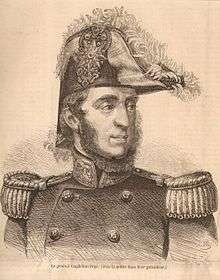
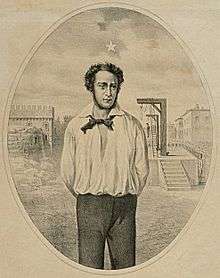

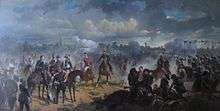

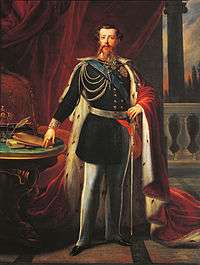

.jpg)
